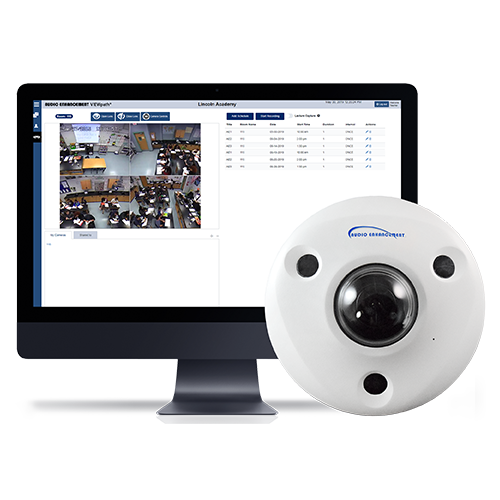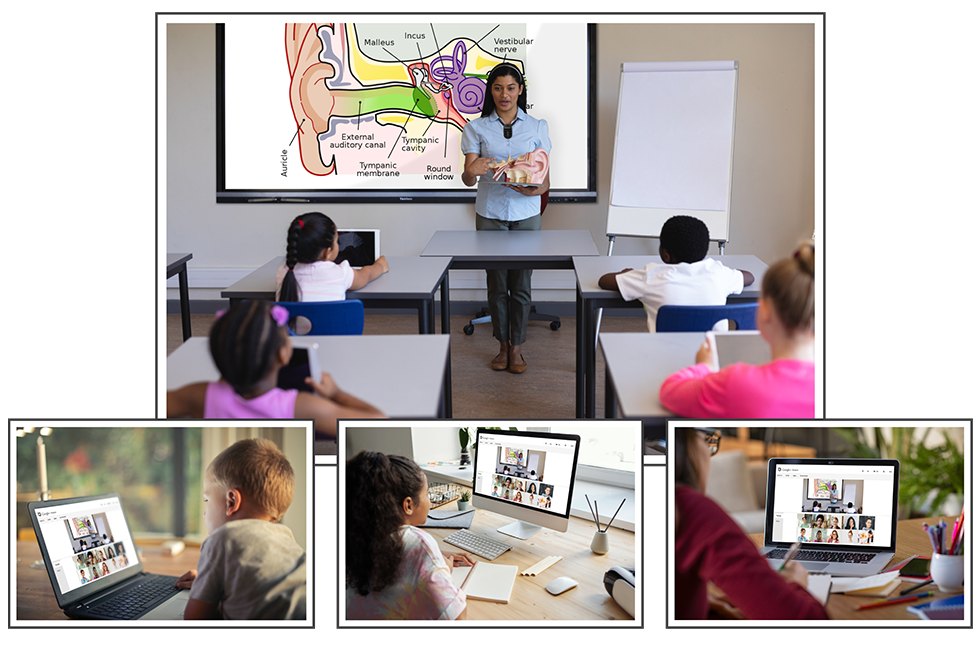VIEWpath Live
Conferencing Best Practices

Welcome to VIEWpath, Audio Enhancement’s blended learning solution for schools. As you work with our system, or any other system that is using virtual video conferencing technology, we wanted to provide you with some ideas of ways that you can maximize the efficiency, and create the best possible experience for all of the participants.
Just like your physical classroom, your virtual classroom or blended classroom will require a set of classroom management tools. You have been taught and are effectively using classroom management tools since your first days in the classroom. However, with the addition of the virtual or blended environments, those same tools need to now be adjusted to fit this new paradigm.
If you take nothing else from this best practice page, please take this one guiding principal: Your best situation will be to have only one microphone active at any given time.
Who is Supposed to be Talking?

In the physical classroom, it is easy to manage who is talking. Teachers have used raising of hands, talking sticks, talking feathers, student microphones and other techniques over the years to manage who is talking. Students are taught and expected to be quiet until they are called on or provided with the token giving them permission to speak. In the virtual classroom, it is even more important to manage who is talking, except now you as the teacher have a mute button for every student. Additionally, when you add the virtual classroom into the mix, it is not enough for the student to just sit there quietly.
The technology itself cannot differentiate between when the student is speaking, or when their sibling across the table is talking, the truck outside their window is driving by loudly, or the dog is barking. All those events, to the technology, are the same. If that microphone is un-muted it will be accepted into the system and attempt to be processed just the same as when the teacher is talking.
A Bit of Geek Speak
Each of the video conference services (Zoom®, Microsoft Teams®, Google Meets®, etc.) uses an algorithm to perform two basic functions. First, the algorithm is constantly trying to determine who is speaking and bring that person to the forefront. Second, the algorithm is taking the audio coming from participants and perform echo cancellation on each computer participating in the conference. The video conference service cuts out the audio that it thinks is coming back through your local computer to prevent a feedback loop.
When you combine these processes – and there is only one microphone active during a conference call, everything works great. However, as soon as there is more than one microphone un-muted these processes start to compete with themselves and cause problems with the conference call. Additionally, the entire system is vulnerable to excessive noise at any point where there is an un-muted microphone. All that excess sound must be processed by the echo cancellation algorithm and is always considered of the same priority as any other sound when trying to determine who is the speaker.
The consequence of this is that when multiple microphones are un-muted during a video conference call, the students can experience excessive drop out, and an inconsistent audio experience from the teacher in the classroom.
How do you as a teacher take charge and implement classroom management techniques in a virtual or blended environment? The following are some suggestions compiled based on different scenarios a teacher may face. There is one key principal to remember. In a virtual or blended learning environment, the optimum situation will always be that only one microphone is active at any given time.
Direct Instruction
In the physical classroom, it is easy to manage who is talking. Teachers have used raising of hands, talking sticks, talking feathers, student microphones and other techniques over the years to manage who is talking. Students are taught and expected to be quiet until they are called on or provided with the token giving them permission to speak. In the virtual classroom, it is even more important to manage who is talking, except now you as the teacher have a mute button for every student. Additionally, when you add the virtual classroom into the mix, it is not enough for the student to just sit there quietly.
Student Questions
Encourage your students to use the Chat Feature in your video conference application. If a question is asked in the Chat window, classroom management techniques can again be employed. It has long been taught that the teacher should make sure to repeat the question whenever a student asks a question, making sure that the rest of the students hear the question and the answer. This is fundamental to the learning and questioning process. In this blended learning environment, it also ensures that your students stay muted and do not end up inadvertently disrupting the class for the other students.
In-Class Students in a Blended Environment
Students that can attend in person, should not be logged into the virtual learning environment during the direct instruction portion of the class. Their computers, if logged in virtually, present a potential problem for both the microphone audio bleeding into the virtual environment, and their speaker or headphone audio getting into the teacher’s microphone, and therefore into the virtual environment. It is optimal to keep those students logged out of the virtual classroom, until they move into a small group environment, and can use their own headphones to participate in a small group.
Student Presentations - Virtual Students
During a time when students are presenting back to the entire classroom, they should then be the only participant un-muted. During this time, it is optimal to have the classroom/teacher microphone muted as well. This needs to be muted at the interface, because that is where the video conference application will be able to recognize the state of the teacher interface and give priority to the student that is presenting.
Student Presentations - In-person Students
If you have students that can attend in person, they should use the classroom microphone to do their presentations. Sanitize the microphone before handing it out to the student that will be presenting, but by having them use the classroom student microphone, both the virtual and in-person students will be able to clearly hear everything that the student presenter is saying.
Keep in mind that to the video conferencing system, the student pass around microphone and the teacher microphone are only one microphone, because they are combined at the local classroom amplification system, and presented as a single source of sound to the teacher computer running the video conference call.
